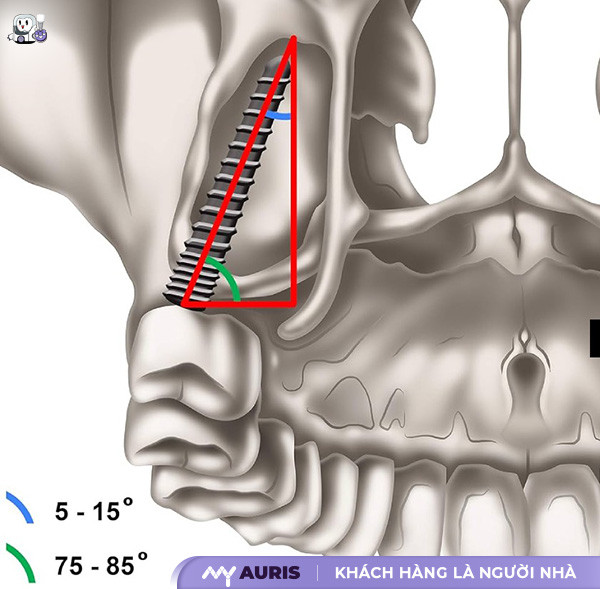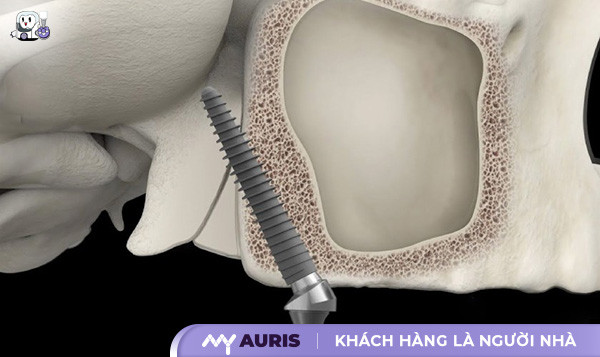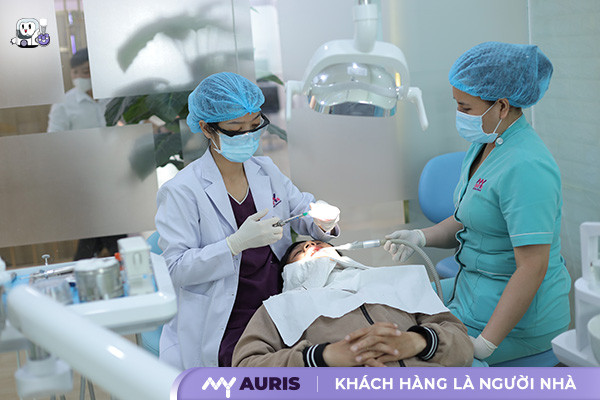Sphenoid Wing Implants, also known as Pterygoid Implants, are a modern and groundbreaking dental implant method in the field of lost tooth restoration. This solution is particularly suitable for cases of severe maxillary bone atrophy, where conventional implant techniques cannot be performed due to insufficient bone volume and quality. Thanks to advanced technology and the in-depth expertise of a team of specialized doctors, this modern technique is opening up opportunities for durable, safe, and highly effective tooth restoration for many patients.
To better understand the benefits and procedure, you can refer to the detailed information in the article below.
What is Sphenoid Wing Implant placement?
Sphenoid Wing Implant placement is an advanced technique applied in cases of severe maxillary bone atrophy in the upper jaw, especially in the posterior tooth region (teeth #5, #6, #7) – where traditional implant placement methods are no longer suitable. In these situations, attempting to place implants conventionally or with bone grafting carries a very high risk of implant non-integration into the jawbone, leading to treatment failure.
Although removable partial dentures may be an option, according to experts, Sphenoid Wing Implant placement remains the optimal and long-term solution for tooth loss, ensuring superior chewing function and aesthetics.
Unlike conventional implants placed vertically, Sphenoid Wing Implants typically range from 13mm to 20mm, or even up to 22mm in length, and are inserted at an angle of 45 – 55 degrees into the pterygoid plate region (sphenoid wing bone). This technique not only minimizes invasiveness but also avoids the need for sinus lifts and bone grafting, thereby reducing post-surgical complications.
When performed correctly by highly skilled specialists, Sphenoid Wing Implants achieve robust stability, ensuring natural chewing function and sustainably restoring the beauty of the smile.

Outstanding Advantages of Sphenoid Wing Implants
Sphenoid Wing Implant placement is a breakthrough in modern dentistry, particularly effective in complex cases of upper jaw tooth loss where traditional implant placement is not feasible. This method is highly regarded for its many outstanding advantages, contributing to the restoration of lost teeth, facial aesthetics, chewing ability, and ultimately improving the quality of life for patients.
Applicable to Complex Cases
For cases such as severe maxillary bone atrophy, congenital anodontia, or maxillary sinus membrane proximity to the alveolar bone, Sphenoid Wing Implants offer an effective lifeline. This technique allows for stable implant placement without interfering with weak bone areas or complex anatomical regions, providing an optimal restoration opportunity for those previously deemed unsuitable for conventional treatment.

High Success Rate Up to 98% Recognized by Experts
According to expert assessment, a 98% success rate when performing Sphenoid Wing Implant placement is testament to the effectiveness of this method. The new technique minimizes invasiveness, avoids the need for sinus lifts and bone grafting, yet still ensures durable implant stability within the jawbone.
No Need for Sinus Lifts or Bone Grafting
Unlike conventional implant cases with bone atrophy that require bone grafting or an additional sinus lift procedure to ensure sufficient jawbone quantity and quality, with Sphenoid Wing Implant placement, patients do not need sinus lifts or bone grafting. This helps limit trauma, reduce complications, and shorten treatment time, providing a gentler, safer treatment experience.
Can Be Combined with Other Implant Types
Sphenoid Wing Implants can be combined with other implant types such as traditional implants or All-on-X implants to meet full-arch restoration needs. Depending on each individual’s condition, 2, 3, 4, or even 5 or 6 implant posts may be placed, sometimes in multiple sessions to ensure patient safety throughout the treatment process.
Easy to Clean and Care For
Implant teeth resemble natural teeth in both form and function. After implantation, patients can easily clean and care for them by thorough brushing, using dental floss, and combining with mouthwash to ensure long-term healthy teeth and gums.

My Auris Dental Clinic – A Reliable Address for Standard Sphenoid Wing Implant Placement
Sphenoid Wing Implants are a modern, minimally invasive solution that shortens overall treatment time and allows for immediate post-surgical placement. As a result, patients can achieve a complete set of teeth in just one day. This method not only boasts a high success rate but also ensures long-term stability when performed with the correct technique and procedure.
However, to achieve optimal results, the Sphenoid Wing Implant method requires a team of highly skilled maxillofacial specialists with profound professional knowledge and practical clinical experience. Concurrently, the medical facility must meet all the following standards:
At My Auris Dental Clinic, the implant treatment process in general, and Sphenoid Wing Implants in particular, utilize the latest dental technologies. This not only optimizes effectiveness but also provides patients with a safe, comfortable, and absolutely precise treatment experience.
My Auris’s machinery system is uniformly and modernly invested, providing maximum support in every stage of implant placement. From 3D Cone Beam CT scans and implant simulation software to precise implant guidance devices, all are integrated with high technology.
My Auris boasts sterile operating rooms, fully equipped with modern anesthesia, resuscitation, and emergency systems, strictly adhering to Ministry of Health regulations – a vital factor to ensure maximum patient safety.
All implant posts used at My Auris are genuine products, imported from reputable global suppliers such as Straumann, Nobel Biocare, MIS… We commit to transparency regarding origin and provenance, providing absolute peace of mind to our customers.
Detailed Answers to Frequently Asked Questions about Sphenoid Wing Implants
Sphenoid Wing Implant placement is an advanced technique receiving significant interest from patients with severe tooth loss and bone atrophy. Below is a compilation of frequently asked questions regarding this method, compiled by Nhan Tam Dental Clinic, to help you gain a clearer and more comprehensive understanding.
Are Sphenoid Wing Implants Safe?
Sphenoid Wing Implants are an effective and safe option due to their ability to limit sinus lifts and eliminate the need for bone grafting, thereby reducing invasiveness and minimizing pain for the patient. Furthermore, the reported complication rate is very low if the treatment is performed by a skilled, experienced dentist, combined with modern technology and active patient cooperation in post-surgical dental care.
The hospital is one of the facilities that fully meets stringent standards to ensure maximum safety for this method. If you are wondering whether Sphenoid Wing Implants are suitable for your jawbone condition, schedule a free consultation for a thorough examination. With this technique, you can fully regain a confident smile even with severe bone atrophy.
What is the Cost of Sphenoid Wing Implant Placement?
The price for Sphenoid Wing Implant placement is not fixed and depends on factors such as:
- The complexity of the treatment case
- The dental clinic you choose
- The quality of materials and accompanying services
For an accurate quote, you should visit a reputable dental clinic for a thorough examination and specific consultation with a dentist, who can then develop a treatment plan that suits your financial situation and personal needs.
Should I Choose Sphenoid Wing Implants or Zygomatic Implants?
Both techniques are for patients with severe upper jawbone atrophy; however, each method has its distinct characteristics:
- Zygomatic implants are placed deep into the cheekbone (zygoma), with lengths ranging from 30 – 50mm, suitable for extremely severe bone loss cases.
- Sphenoid Wing Implants are inserted into the pterygoid plate region of the sphenoid bone, located behind the upper jaw, with lengths of approximately 13 – 20mm, making them less invasive and suitable for most patients.
Note: Zygomatic implants require a high level of expertise due to their proximity to critical anatomical structures such as the maxillary sinus and eye socket. In cases where even Sphenoid Wing Implant placement cannot be performed, zygomatic implants will be the final option.
How Long Does Recovery Take After Sphenoid Wing Implant Placement?
One of the most prominent advantages of this technique is the extremely rapid recovery time. Since no sinus lift or bone grafting is required, patients can chew immediately on the day of surgery with temporary teeth.
Rapid recovery minimizes downtime, making it suitable for busy individuals or those who need to recover quickly to resume normal daily activities and work.





